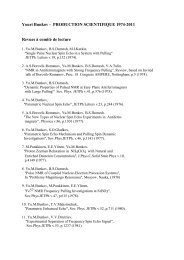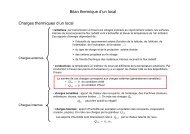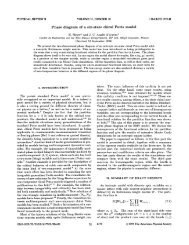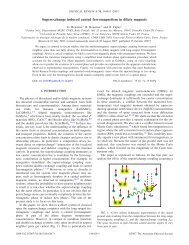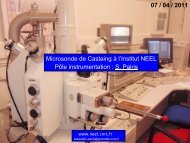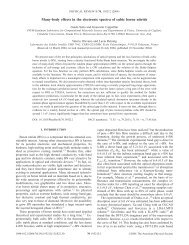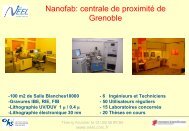Activity Report 2010 - CNRS
Activity Report 2010 - CNRS
Activity Report 2010 - CNRS
Create successful ePaper yourself
Turn your PDF publications into a flip-book with our unique Google optimized e-Paper software.
CONTROL OF THERMAL<br />
CONDUCTIVITY AT THE<br />
NANOSCALE<br />
The ability to precisely control the<br />
thermal conductivity of a material is<br />
fundamental in the development of onchip<br />
heat management or energy<br />
conversion. By engineering a set of<br />
individual phonon-scattering nanodot<br />
barriers, researchers from the University<br />
of Bordeaux, IFW Dresden, and Liten,<br />
have accurately tailored the thermal<br />
conductivity of a single-crystalline SiGe<br />
material in spatially defined regions as<br />
short as 15 nm, attaining ultra low<br />
thermal conductivities below 1 W/m-K.<br />
The motivation of this study was to know<br />
whether it is possible to achieve fully<br />
diffusive phonon barriers in a single<br />
crystalline material.<br />
Previous studies on planar Si/SiGe<br />
superlattices had reported reductions in<br />
thermal conductivity compatible with<br />
partially diffusive interfaces. In our case,<br />
having dots rather than flat layers leads<br />
to a much stronger phonon scattering,<br />
and allows us to achieve fully diffusive<br />
barriers.<br />
The single crystalline nanodot samples<br />
were grown at IFW Dresden.<br />
Measurements of their thermal<br />
conductivity were performed by two<br />
different methods:<br />
3- method (by A. Rastelli at IFW<br />
Dresden)<br />
time domain thermoreflectance<br />
(TDTR), by S.Dilhaire at the University of<br />
Bordeaux.<br />
Theoretical modelling of flat and nanodot<br />
based superlattices was performed at<br />
Liten, employing atomistic Green’s<br />
function methods.<br />
The thermal conductivity was measured<br />
in the cross plane direction. Singlebarrier<br />
thermal resistances between 2<br />
and 4x10 -9 m 2 K W -1 were attained. This<br />
results in a room-temperature<br />
conductivity down to about 0.9Wm -1 K -1 ,<br />
in multilayered structures with only five<br />
barriers.<br />
Such low thermal conductivity is<br />
compatible with a totally diffuse<br />
mismatch model for the barriers, and it is<br />
well below the amorphous limit. The<br />
results are in agreement with atomistic<br />
Green’s function simulations.<br />
HIGHLIGHT : THEORY AND NANOSIMULATION<br />
Fig. 1: Schematic of the self-assembled<br />
nanodot multilayers fabricated by molecular<br />
beam epitaxy.<br />
Fig. 2: Experimental thermal conductivities of<br />
the samples, as a function of period length<br />
This demonstrated ability to tailor<br />
thermal conductivity with 1 Wm -1 K -1<br />
precision and confirmed a spatial<br />
resolution below the 20nm range which is<br />
very relevant to the development of<br />
integrated miniaturized energy<br />
harvesting or thermal management<br />
devices, fully compatible with silicon<br />
nanoelectronics.<br />
CONTACTS<br />
natalio.mingo@cea.fr<br />
FURTHER READING<br />
G.Pernot et al., Nature Materials, 9, 491<br />
(<strong>2010</strong>).<br />
14



